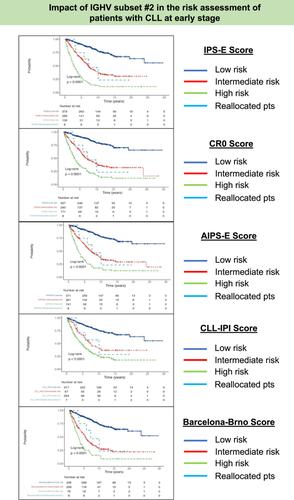Risk scores predicting disease progression in early‐stage CLL: Comparative analysis and usefulness of IGHV subset #2 to improve their accuracy
IF 6.1
2区 医学
Q1 ONCOLOGY
引用次数: 0
Abstract
BackgroundOverall, the prognosis of patients with chronic lymphocytic leukemia (CLL) in the early phase of the disease (Rai 0, Binet A) is favorable; some patients never require therapy. However, some patients require intervention shortly after diagnosis. In the past decade, several risk scores (RS) have been developed to predict disease progression, yet some patients are misclassified. On the other hand, IGHV subset 2 (IGHV2) predicts poor outcomes.MethodsA retrospective and multicentric study was conducted to compare the accuracy of five different RS (IPS‐E, CR0, AIPS‐E, CLL‐IPI, and Barcelona‐Brno) to predict disease progression in 781 stage A previously untreated patients with CLL. As an exploratory analysis, it was further investigated whether the inclusion of the IGHV2 as a poor prognostic parameter improved the accuracy of RS.ResultsAll the scores identified a similar group of patients with CLL in early stage with low‐, intermediate‐, and high‐risk progression. Discrimination was high and similar in all RS (c‐index = 0.74–0.79, area under the curve = 0.7–0.75), as well as calibration (

预测早期 CLL 疾病进展的风险评分:IGHV 子集 #2 的比较分析和提高其准确性的实用性
背景总体而言,慢性淋巴细胞白血病(CLL)早期(Rai 0,Binet A)患者的预后良好;一些患者从不需要治疗。然而,有些患者在确诊后不久就需要进行干预。在过去的十年中,已经开发出几种风险评分(RS)来预测疾病的进展,但仍有一些患者被误诊。该研究比较了五种不同风险评分(IPS-E、CR0、AIPS-E、CLL-IPI 和 Barcelona-Brno)预测 781 例 A 期既往未经治疗的 CLL 患者疾病进展的准确性。作为一项探索性分析,我们进一步研究了将 IGHV2 作为不良预后参数是否能提高 RS 的准确性。结果所有评分都能识别出类似的低危、中危和高危早期 CLL 患者。尽管 CLL-IPI 显示出最好的结果(阿凯克信息标准 = 441),但所有 RS 的区分度都很高且相似(c 指数 = 0.74-0.79,曲线下面积 = 0.7-0.75),校准性(p = 0.98)和解析性也很高。此外,结果表明 IGHV2 可提高 RS 的准确性。
本文章由计算机程序翻译,如有差异,请以英文原文为准。
求助全文
约1分钟内获得全文
求助全文
来源期刊

Cancer
医学-肿瘤学
CiteScore
13.10
自引率
3.20%
发文量
480
审稿时长
2-3 weeks
期刊介绍:
The CANCER site is a full-text, electronic implementation of CANCER, an Interdisciplinary International Journal of the American Cancer Society, and CANCER CYTOPATHOLOGY, a Journal of the American Cancer Society.
CANCER publishes interdisciplinary oncologic information according to, but not limited to, the following disease sites and disciplines: blood/bone marrow; breast disease; endocrine disorders; epidemiology; gastrointestinal tract; genitourinary disease; gynecologic oncology; head and neck disease; hepatobiliary tract; integrated medicine; lung disease; medical oncology; neuro-oncology; pathology radiation oncology; translational research
 求助内容:
求助内容: 应助结果提醒方式:
应助结果提醒方式:


